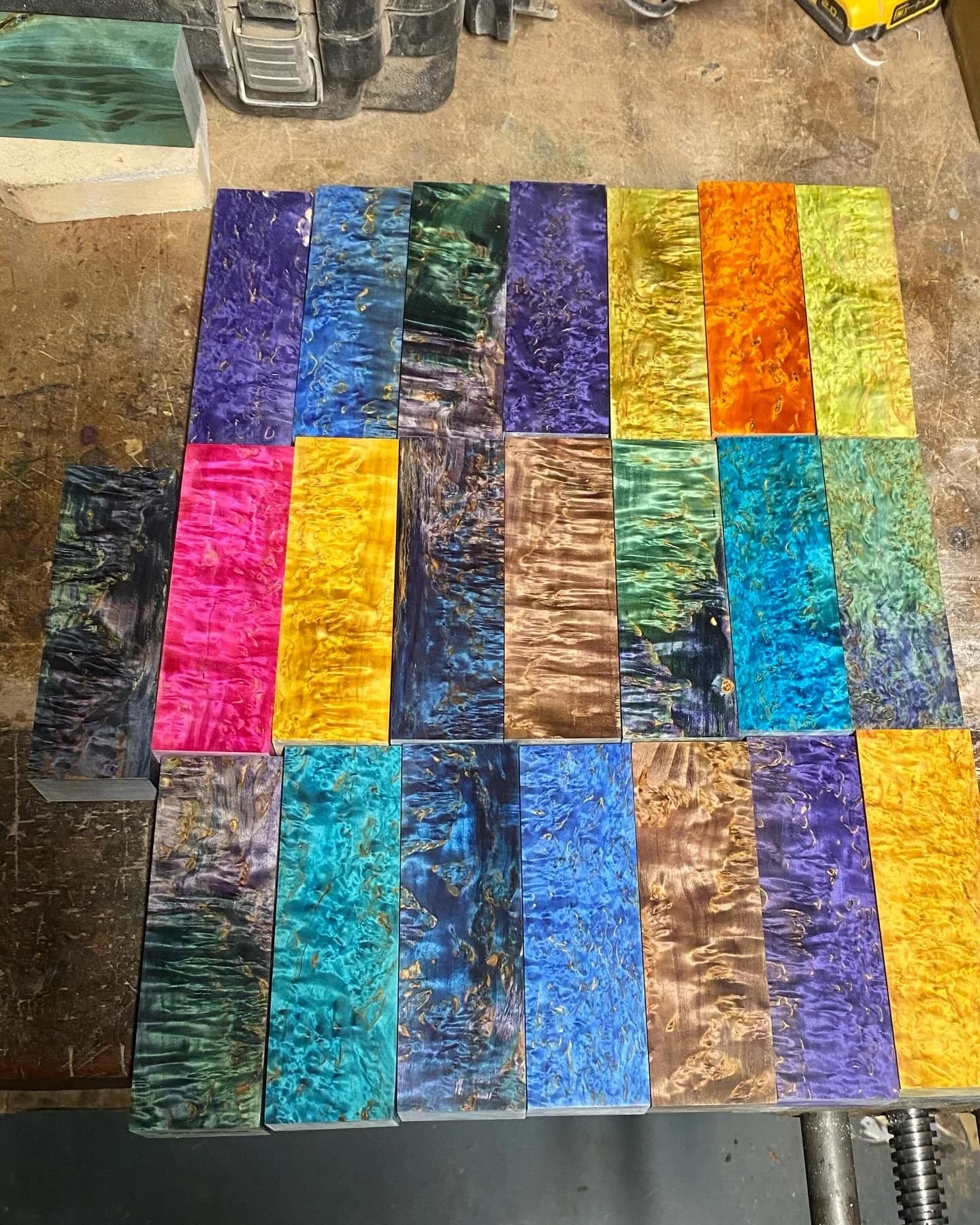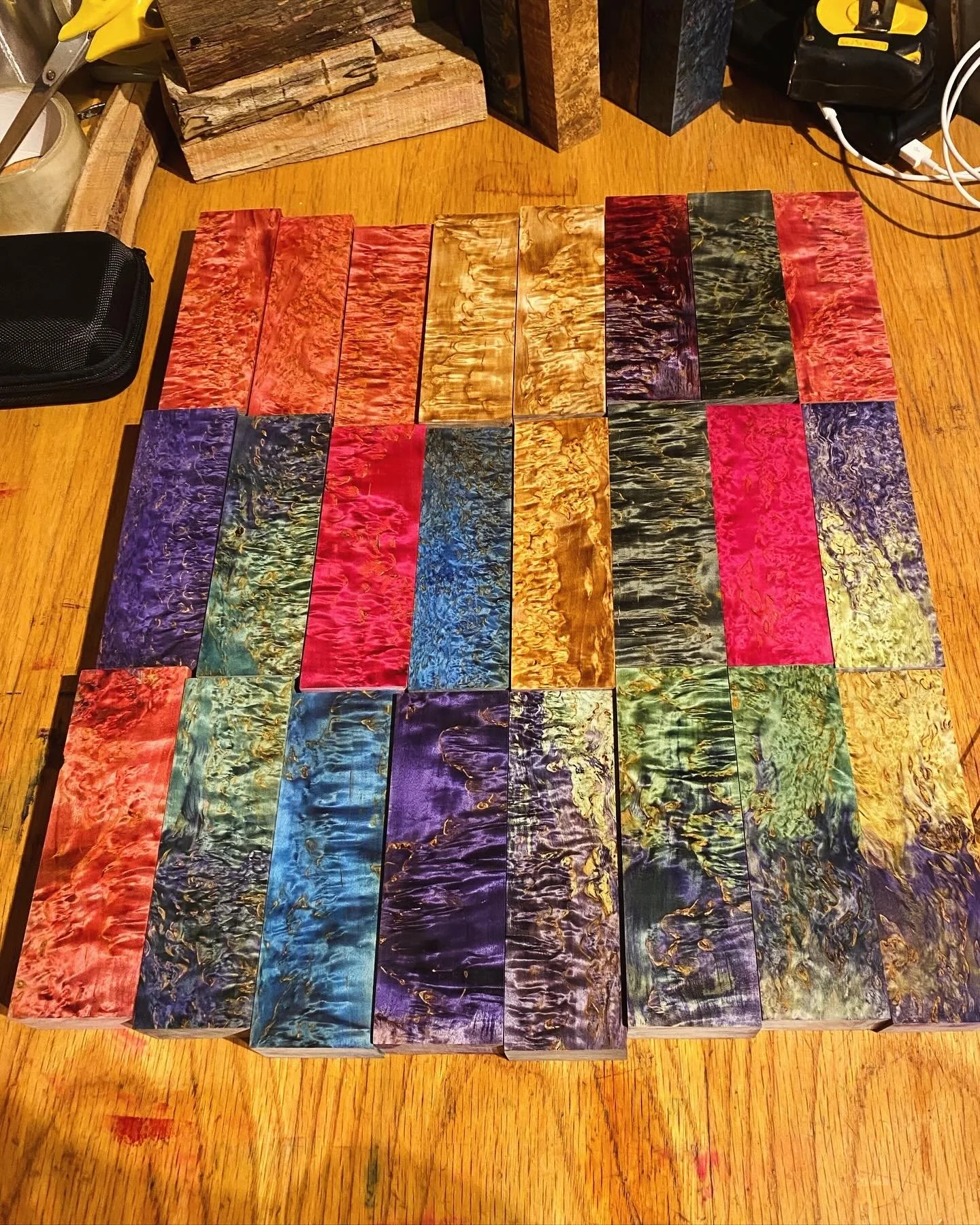What is Stabilised Wood
Stabilised wood is a type of composite material, It is a timber that has had an acrylic polymer (Usually Methylacrylate Esther based resin) dissolved into a solvent, and then forced into the wood through a mix of vacuum and pressure cycles. The wood is then heated to drive off the solvent and cure the resin. This leaves a product that is harder, denser, stronger, resistant to water, resistant to warpage, and will take a much higher polish than natural wood. Stabilised wood is definitely the best choice for pieces that will be handled often, will be around water or large changes in humidity, and for highly figured or finished woods where the finish could become damaged or scuffed in time due to the relative softness of the material.
Knife makers absolutely love stabilised woods, as even small amounts of natural wood movement can disrupt the alignment, or cause scales to peel away from a tang, or even open up very small gaps. It also allows much softer woods like spalted beech and maple burl to be used as handles. Naturally, these woods are far too soft and would gouge, scuff, and mark far too easily, but by stabilising them these amazing woods can be used for knife handles.
How do I know if a piece of wood is stabilised?
It all starts with the sourcing, If you did not buy it from a knife maker, or knife supplier, it is almost definitely not stabilised. The process is very expensive and time consuming, and is not commonly used outside of these industries. Stabilised wood that has not been sanded will usually be a bit darker due to the heat used to cure the resin. This is not always the case though, the easiest way to tell is to sand with a high grit belt. Stabilised woods will almost always produce a distinctly whiteish dust when sanded and a slightly sweet smell regardless of the species of wood.
95% of the wood available on my website has been stabilised, only a small number of handpicked, incredibly dense and stable species are left natural due to the risks and incredibly minimal benefits that it may gain from stabilising.
How do you stabilise wood?
There is no one real right answer as to how to stabilise wood, all professional stabilisers will use different processes, different vacuum times, pressures, soak lengths etc. Stabilising is the process of using vacuum to remove all of the air from a piece of wood and then utilising pressure differentials to force that resin into the block.
First the wood needs to be dried out to 0% MC, this takes the wood to the point where it wants to rehydrate to the ambient moisture content of the local area (12-14% around the north east of England), this is called its hygroscopic equilibrium. Once cool, it gets placed in a vacuum chamber submerged in the stabilising resin, this almost creates a one way valve keeping the air inside the block. A vacuum is then pulled, this takes the system from high pressure at the bottom of the chamber with the wood and resin and low pressure at the top of the chamber where the airspace is, as this equalises over 3-4 days it transitions to low pressure at the bottom of the chamber with the wood and resin and high pressure at the top of the chamber where the airspace is. Once it is at this point the vacuum can be released, this is where the pressure differential is formed and the magic happens. The vacuum being held in the wood allows the resin to be sucked in, the atmospheric pressure pushing in on the blocks also forces this resin in. I use 450psi pressure chambers in my processes, this further exacerbates the pressure differential forcing more resin into the wood at a much quicker rate. Finally once it has soaked, it is cured in a convection oven at 95°C, this boils off the solvent in the resin leading to a fully stabilised block of wood.
https://www.youtube.com/watch?v=DdaBfscf2IY
This is a link to a video I did with Vinz from UKbladeshow explaining my processes back in 2022
How much does Stabilising help?
There is no one right answer. It varies by both species and the individual piece. Wood is a natural product, and a product of its environment. Plantation grown wood that was not exposed to high stresses will generally be lighter and less dense than woods growing in poor soil, exposed to heavy winds and other environmental stresses.
Very light woods such as heavily decayed spalted blocks will roughly double or triple in weight when properly stabilised. They will go from soft and almost foam like to absolutely rock solid, I have developed a unique, multi stage process over years of research and development that allows very soft pieces to be saved from the firewood pile.
Medium density woods like Masur Birch, Amboyna, Walnut and bog oak will gain roughly 60%-80% weight, and will become super dense, these blocks will be a little easier to finish than some of the softer pieces due to a higher quantity of wood fibres in the piece (Less air space, Denser wood)
Dense woods like ebony, rosewood, and Ironwood benefit very minimally, if at all from stabilising. Species like Ebony can become more stable and resistant to cracking due to humidity changes, but in my experience the advantages are relatively minor and the choices need to be made on a very case specific basis.
I tried to stabilise my own and it cracked and warped! What happened?
It was wet. in 99.9% of cases cracking is caused by moisture in the wood, all wood starts very wet, seasonally changing in moisture content and tree health too. Drying wood is a slow, painstaking and very difficult process, especially for figured or burr blocks. to dry a piece properly it needs to be treat correctly as soon as it is felled, if not it can cause a multitude of issues down the line. I primarily use a vacuum kiln for the drying of my wood, whilst it is an excellent piece of equipment it does have downsides. If you take it too quickly it may crack and warp but it also introduces a lot of Interfibrillar tension, this is the main cause of scales warping whilst being cut.
Please see my page on warping to understand a little more about it.
What stabilising does NOT do.
Stabilising will not fill voids or gaps. Stabilising resin will saturate the fibres of the wood, it will not fill gaps. For large gaps or voids, use epoxy and for small gaps use CA glue.
Stabilising also does not make wood plastic. Properly stabilised wood still looks like and works like wood. It still has a grain structure and can be worked with chisels, saws and abrasives. It simply strengths and enhances the wood.
After finish sanding, multiple layers of a standard finishing oil or wax can be applied to enhance the appearance and protect the finish.
It is important to know that not all woods can be stabilised too. Woods that are very high in oil like Robinia, some Cedars, Camphor and others do not stabilise well, they have low weight gain and may not set properly.















